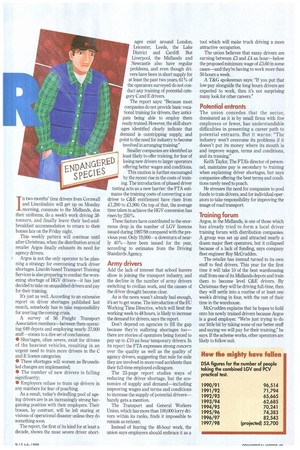DRIVER SHORTAGE
Page 50

Page 51

If you've noticed an error in this article please click here to report it so we can fix it.
As the alarming fall in HGV applicants continues, one Midlands-based retailer has been forced to import drivers from the West Country to ease shortages.
Karen Miles reports on the manpower crisis the industry resolutely refuses to face.
/ n two months' time drivers Cornwall
ow Cornwa and Lincolnshire will get up on Monday
/ n two months' time drivers Cornwall
and Lincolnshire will get up on Monday morning, commute to the Midlands, don their uniforms, do a week's work driving 38tonners, and finally leave their bed-andbreakfast accommodation to return to their homes late on the Friday night.
This weekly pattern will continue until after Christmas, when the distribution arm of retailer Argos finally exhausts its need for agency drivers.
Argos is not the only operator to be planning a strategy for overcoming truck driver shortages. Lincoln-based Transport Training Services is also preparing to combat the worsening shortage of HGV drivers—it has just decided to take on unqualified drivers and pay for their training.
It's just as well. According to an extensive report on driver shortages published last month, somebody has to take responsibility for averting the coming crisis.
A survey of 56 Freight Transport Association members—between them operating 649 depots and employing nearly 37,000 staff—comes to a dire set of conclusions: • Shortages, often severe, exist for drivers of the heaviest vehicles, resulting in an urgent need to train more drivers in the C and E licence categories; • These shortages will worsen as Brusselsled changes are implemented; • The number of new drivers is falling significantly • Employers refuse to train up drivers in any numbers for fear of poaching.
As a result, today's dwindling pool of ageing drivers are in an increasingly strong bargaining position with their employers. Their bosses, by contrast, will be left staring at visions of operational disaster unless they do something soon.
The report, the first of its kind for at least a decade, shows the most severe driver short
ages exist around London, Leicester, Leeds, the Lake District and Cardiff. But Liverpool, the Midlands and Newcastle also have regular problems, and even though drivers have been in short supply for at least the past two years, 61% of the operators surveyed do not conduct any training of potential category C and E drivers.
The report says: "Because most companies do not provide basic vocational training for drivers, they anticipate being able to employ them ready-trained. However, the skill shortages identified clearly indicate that demand is outstripping supply, and point to the need for industry to become involved in arranging training."
Smaller companies are identified as least likely to offer training, for fear of losing new drivers to larger operators offering better wages and conditions.
This caution is further encouraged by the recent rise in the costs of training. The introduction of phased driver testing acts as a new barrier: the ETA estimates the training costs of converting a car driver to C&E entitlement have risen from £1,200 to £1,900. On top of that, the average time taken to achieve the HGV conversion has risen by 250%.
These factors have contributed to the enormous drop in the number of LGV licences issued during 1997/98 compared with the previous year. Only 19,000—a downturn of nearly 40%—have been issued for the year, according to estimates from the Driving Standards Agency.
Army drivers
Add the lack of interest that school leavers show in joining the transport industry, and the decline in the number of army drivers switching to civilian work, and the causes of the driver drought become clear.
As is the news wasn't already bad enough, it's set to get worse. The introduction of the EU Working Time Directive, which will limit the working week to 48 hours, is likely to increase the demand for drivers, says the report Don't depend on agencies to fill the gap because they're suffering shortages too— there are stories of operators being forced to pay up to £10 an hour temporary drivers. In its report the PTA expresses strong concern over the quality as well as the quality of agency drivers, suggesting that mile for mile they are involved in more road accidents than their full-time employed colleagues, The 23-page report studies ways of reducing the driver shortage, but the economics of supply and demand—including improving wages and terms and conditions to increase the supply of potential drivers— barely gets a mention.
The Transport and General Workers Union, which has more than 100,000 lorry drivers within its ranks, finds it impossible to remain as reticent.
Instead of fearing the 48-hour week, the union says employers should embrace it as a tool which will make truck driving a more attractive occupation.
The union believes that many drivers are earning between £3 and £4 an hour—below the proposed minimum wage of £3.60 in some cases—and they're having to work more than 50 hours a week.
A T&G spokesman says: "If you put that low pay alongside the long hours drivers are expected to work, then it's not surprising many look for other careers."
Potential entrants
The union concedes that the sector, dominated as it is by small firms with five employees or fewer, has understandable difficulties in presenting a career path to potential entrants. But it warns: "The industry won't overcome its problems if it doesn't put its money where its mouth is and improve wages, terms and conditions, and its training" Keith Taylor, The PTA's director of personnel, maintains pay is secondary to training when explaining driver shortages, but says companies offering the best terms and conditions rarely need to poach.
He stresses the need for companies to pool funds to train drivers, and for individual operators to take responsibility for improving the image of road transport
Training forum
Argos, in the Midlands, is one of those which has already tried to form a local driver training forum with distribution companies. A group was set up and attracted nearly a dozen major fleet operators, but it collapsed because of a lack of funding, says company fleet engineer Roy McCrudden.
The retailer has instead turned to its own staff to find drivers. This year for the first time it will take 10 of the best warehousing staff from one of its Midlands depots and train them to become level C&E drivers. By Christmas they will be driving full-time, then they will settle into a routine of at least one week's driving in four, with the rest of their time in the warehouse.
McCrudden explains that he hopes to hold onto his newly trained drivers because Argos is a good employer. "We're just trying to do our little bit by taking some of our better staff and saying we will pay for their training," he says. If the scheme works, other operators are likely to follow suit
How the mighty have fallen
DSA figures for the number of people taking the combined LGV and PCV practical test.
1990/91 96,514 1991/92 71,794 1992/93 65,665 1993/94 62,685 1994/95 70,241 1995/96 74,383 1996/97 82,543 1997/98 (projected) 52,700












































































































